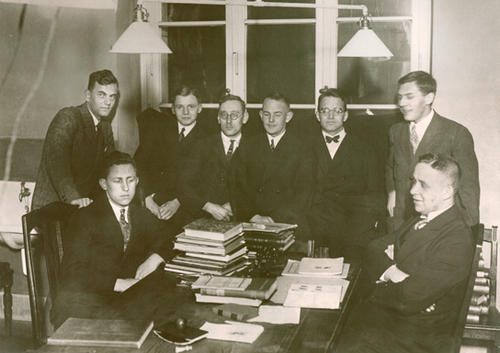History of the Institute
hotograph: Students of Prehistory and Early History at the Friedrich-Wilhelm University in Berlin, winter semester 1927/1928. (left to right) as a major subject: Kurt Bittel, Berlin; Emil Vogt, Zürich; Walter Kersten, Berlin; Kurt Langenheim, Danzig;
The beginnings of Prehistoric Archaeology at Berlin University
Inauspicious beginnings
Teaching of 'Ur und Frühgeschichte' - as Prehistoric Archaeology is often denominated in Germany - was introduced at the Friedrich-Wilhelm University Berlin in 1902 with the establishment of an extraordinary professorship, occupied by Gustav Kossinna (1858–1931). Kossinna, educated as linguist, promoted an approach to the discipline which even at his time was heavily entangled with the 'Völkisch movement' by focussing on the (assumed) connection between material culture and 'peoples' - considering the later as acting entitities. While today the racist message is obvious, it had a strong impact on the discipline at its time even influencing Vere G. Childe up to the 1930ies. Today Kossinna's theses are still important to demonstrate how archaeology should not be practiced.
Focus of research on Southeast Europe in the Weimar Republic
The subject of Prehistoric Archaeology received quite a different character through the teachings of Max Ebert (1879–1929). Ebert - professor 1927 to 1929 - moved the focus of research at Berlin to eastern and southeastern Europe and its ties to the Black Sea and the Mediterranean. Ebert founded and edited the 'Reallexikon der Vorgeschichte' from 1924 onwards, a monumental encyclopedia of prehistory with contributions from leading international scholars across Europe that remained a standard for decades to come.
Political science in the Third Reich
After a lengthy vacancy Hans Reinerth (1900–1990) was made professor in 1934 with the support of the 'Amt Rosenberg', the office for surveillance of 'Weltanschauung' (ideology) of the NSDAP. Especially Reinerth's later activities, e.g. his involvement in the robbery of cultural heritage from Ukraine in 1942, mark the moral bancruptcy of Prehistoric German Archaeology. The case of Reinerth is also symptomatic for the early postwar reappraisal of Nazi archaeology in western Germany where he was depicted as the 'single culprit' by colleagues who, many not less guilty than Reinerth, had feuded with him in internal power struggles during the third Reich.
From the cold war to the present
The two institutes
From 1945 into the 1950s prehistoric archaeology ceased to exist as an academic discipline in Berlin. In 1948 the 'Freie Universität Berlin' was founded by academics and students at Berlin-Dahlem (in the democratic part of cold war Berlin) in reaction to Soviet ideological and political dominance at the 'Universität unter den Linden' (former Friedrich Wilhelm Universität, today Humboldt Universität) leaving the divided city with two universities. With the beginning of the 1950s the museologist Otto-Friedrich Gandert (1898–1983) lectured prehistory for some years at Freie Universität. In 1959 the 'Institut für Ur- und Frühgeschichte' was established with Horst Kirchner (1913–1990) as director. Yet already in 1956 prehistoric archaeology was re-established at Humboldt Universität. So for the next some 50 years two university institutes for prehistoric archaeology existed side by side in Berlin, up to 1989 a divided city.
The 'Institut für Prähistorische Archäologie'
In the course of changes since the end of the 1960s the institute at Freie Universität became the 'Seminar für Ur- und Frühgeschichte' as part of the academic faculty of archaeological sciences. Considering international nomenclature the Institute was renamed 'Institut für Prähistorische Archäologie' (Institute for Prehistoric Archaeology) in 2000 - still today the only German academic institution using the international nomenclature. In 2011 teaching of prehistoric archaeology at Humboldt Universität was abandoned leaving the 'Institut für Prähistorische Archäologie' as the only representantive of 110 years of tradition in academic prehistoric archaeology in Berlin.
Today the institute has again turned its focus towards southeastern and eastern Europe, as initiated by Max Ebert in the 1920s. As one of the leading German academic institutions for the archaeology of southeastern and eastern Europe the 'Institut für Pähistorische Archäologie' conducts projects with respective partners from Greece to Russia and from Poland to Moldavia.
